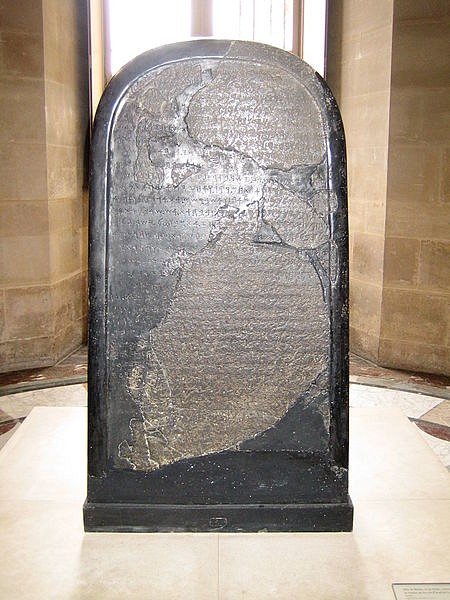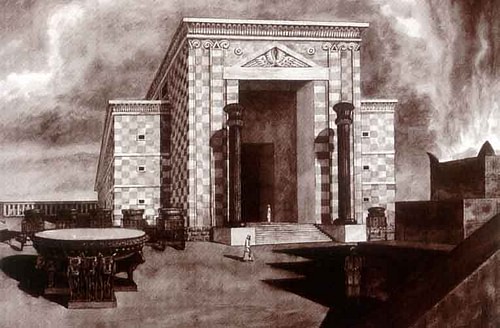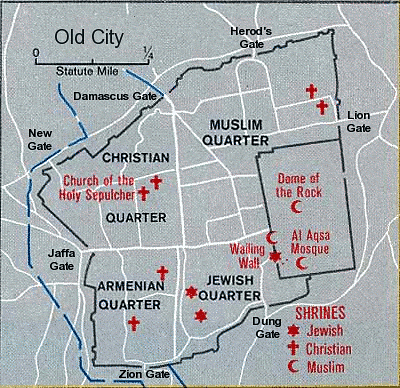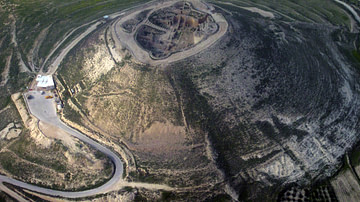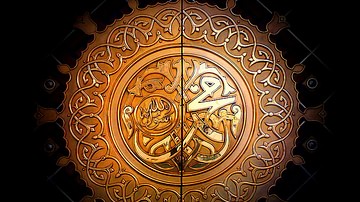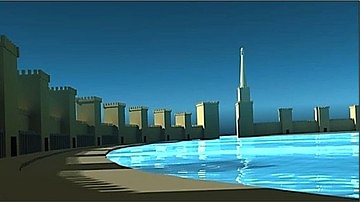
Jerusalem is a major holy city for the three Western traditions of Judaism, Christianity, and Islam. It sits on spurs of bedrock between the Mediterranean Sea and the Dead Sea area. To the north and west, it tapers off to the Jezreel Valley and the hills of the Galilee, while to the south lies the Judean desert. The city is surrounded by three steep ravines (to the east, south, and west). On the other side of the eastern ravine, across the Kidron valley, is the Mount of Olives.
Historically, Jerusalem was an urban center for approximately 5,000 years. Scholars debate the original meaning of the name (Sumerian "foundation" or Semitic "to found" or to "lay a cornerstone"). It could also derive from the name of the Canaanite god of dusk, Shalem, where the main consonants of s-l-m also denote the Hebrew (salam or shalom), which means "peace." Ironically, the city has known very little peace over the centuries.
Today, Jerusalem consists of the modern, western section, built up after the institution of the state of Israel in 1948, and the medieval section, known as the Old City, which is surrounded by walls and gates built during the reign of Suleiman I (1494-1566) when the province was part of the Ottoman Empire. The Old City is divided into four quarters: the Jewish Quarter; the Christian Quarter; the Muslim Quarter; and the Armenian Quarter.
Archaeology of the Biblical Period
The major source for the history of ancient Jerusalem is the Bible and the writings of Flavius Josephus (36-100 CE). In the 19th century, archaeological excavations began in and around Jerusalem essentially to try to prove the biblical stories and to affirm the existence of its major characters such as King David and Solomon. In the modern era, exploration expanded to include all levels of the ancient city.
There is material evidence of occupation in the Chalcolithic Period (4500-3400 BCE) and the Middle Bronze II Period (1800-1500 BCE). The end of the Bronze Age (c. 1200 BCE) saw the invasion and conquest by the New Kingdom of Egypt (under Tuthmose III) and many Egyptian artifacts continue to be found in the excavations at this level. The Iron Age (1200 BCE) included an invasion of the Sea Peoples in the Eastern Mediterranean, named "Philistines" in the Bible. The Philistines introduced both iron and chariots to the region, although Philistine material remains have mainly been found in the Gaza Strip where they settled.
The original occupants of Israel are collected under the umbrella term "Canaanites," consisting of dozens of different tribes that are listed throughout the book of Genesis. In Genesis 12, God called Abraham and his clan to settle in Canaan. According to Genesis 14:18-20, Abraham met and conducted a truce with Melchizedek, "king of Salem," who then blessed Abraham and acknowledged his god as "creator of heaven and earth." There are very few remains from the Canaanite era of Jerusalem when it was allegedly occupied by the tribe of Jebusites (1500-1000 BCE).
A large, stepped stone structure known as the "Ophel" was uncovered on the lower Temple Mount. The term comes from the Mesha stele, erected by King Mesha of Moab to celebrate his victory over Israel and may refer to a fortified hill (840 BCE). Scholars continue to debate its function and relation to the earlier period under King David (c. 1000 BCE).
Two major discoveries help to support some of the information in the Bible. 2 Samuel 5:1-12 relates the story of how David conquered the city by men ascending the water shaft from the Gihon spring up into the city and taking it from within. The shaft was uncovered in 1867 by the British engineer and archaeologist, Charles Warren (1840-1927) and bears his name.
The Siloam Tunnel, also known as Hezekiah's tunnel, connects the springs at the pool of Siloam to the inner city. According to 2 Kings 20:20, king Hezekiah created the tunnel as an extra defense against an impending siege by king Sennacherib of the Assyrians (c. 701 BCE). Warren and another archaeologist, Edward Robinson (1794-1863) explored the tunnel, and an inscription was uncovered on the wall. The inscription described the building of the tunnel and the way in which two teams, each starting from the other end, met in the middle. This inscription is one of the oldest in the Paleo-Hebrew alphabet (a variant of ancient Phoenician).
Tombs
Some Canaanite rock-cut tombs in the city date from 3100-2900 BCE. The earliest Israelite tombs date from the 800s BCE, and then the next surviving levels come from the Second Temple Period, late Roman and early Byzantine eras. Near the Zion Gate in the Old City is a tomb that Jews honor as the tomb of King David. However, many archaeologists have claimed that this edifice was a Crusader construction.
In the Kidron Valley, major tombs and monuments have inscriptions in both Hebrew and Greek. There is a tomb for Queen Helena of Adiabene, a royal from Iraq who converted to Judaism and sent food to Jerusalem during a famine (45-46 CE). Another large tomb, known as the tomb of the Sanhedrin, is north of the city. It was so named because it has 70 chambers and the Sanhedrin was known to have 70 members. It was most likely used by multiple families to bury different generations.
Jerusalem & Judaism
In the book of Deuteronomy 12:5 (and other places), the Israelites are commanded not to worship at any site except in the place that the Lord "will choose." After the conquest of Jerusalem, this 'place' was aligned with the biblical tradition that Jerusalem sat atop the site known as Mt. Moriah, the mountain where Abraham demonstrated his faith when God told him to offer his son as a sacrifice. The Bible describes the first temple built there by King Solomon (970-931 BCE) and several artifacts have been found that bolster the existence of this temple.
The Temple of Solomon, along with the city of Jerusalem, was destroyed by the Babylonian Empire (587/586 BCE, during the reign of Nebuchadnezzar II, and many priests and aristocrats were taken captive and moved to Babylon. This period is known as "the Exile"; the books of the Jewish scriptures may have reached their final form here. After the Babylonian Empire was conquered by Cyrus the Great of Persia (c. 600-530 BCE), he permitted the Jews to return and rebuild Jerusalem and the Temple. This period is known as the Second Temple Period (515 BCE to 70 CE).
C. 330 BCE, Alexander the Great conquered most of the territories in the eastern Mediterranean, including Jerusalem. After his death (323 BCE), his empire was divided among his generals in the Wars of the Diadochi, and for decades, the Seleucid Empire and the Ptolemaic Dynasty fought over Israel and Jerusalem.
In 167 BCE, a Seleucid king, Antiochus Epiphanes IV (215-164 BCE), took the extraordinary measure of outlawing Jewish rituals and practices. He defiled the Temple and ordered Jews to worship the Greek pantheon. Under the leadership of Mattathias (of the house of Hasmonea), the Jews revolted and eventually drove out the Greeks. Known as the Maccabean Revolt (named after the eldest son, Judah Maccabeus), the Jews purified and rededicated the Temple and Israel became an independent kingdom under the Hasmonean Dynasty.
In 63 BCE, Jerusalem was conquered by the Roman general, Pompey the Great. Rome selected a local tribal chief, Herod, as their client king in the area. In addition to building monumental fortresses and palaces, Herod renovated the Temple and the platform of the Temple Mount. Remnants of his renovation can still be seen in some of the ashlar walls of the old city. A large section of one of his retaining walls constitutes the Western Wall (formerly the "Wailing Wall") in the Jewish Quarter and is a sacred site for Jews.
In 66-73 CE, the Jews revolted against the Roman Empire. The general in charge of the Roman army was the future Roman emperor Vespasian (r. 69-79 CE). His son, Titus (r. 79-81 CE), laid siege to Jerusalem. In 70 CE, the Temple walls were breached, and the Temple destroyed. In the Jewish Quarter of the Old City, one can visit the "Burned House," an upper-class remnant of the destruction of the city at this time. One can travel through the "Rabbinic Tunnel" (a passage that is beneath the Muslim Quarter) and still see walls and pillars from the Temple and the Antonia Fortress located in the upper western corner of the Temple Mount. On the eastern and southern side of the city, Herod's walls and the steps and doorways leading up to the Temple remain. Below the steps are the ruins of the mikavot (cisterns) used for ritual cleansing before entering the complex.
In 135-137 CE, the Jews revolted again during the reign of Hadrian (r. 117-138 CE) in what is known as the Bar-Kochba Revolt. After their defeat, Hadrian built a temple on the site of the ruins of the Second Temple, changed the name of the city to his family name, Aelia Capitolina, and forbade Jews to live in the city (which remained in effect until the 4th century CE).
Overlapping the Christian and Jewish Quarters of the Old City are the remains of the 2nd-century CE street known as the cardo, which intersected with other parts of the city. Along this street are the remnants of the shops.
Christianity
Jerusalem remains significant for Christians who continue to revere the Old Testament traditions of the Jews. However, it is much more famous for the holy sites connected to stories of Jesus in the gospels. The pool of Bethesda has recently been excavated; it was found among the later pagan temples of Asclepius and Serapis (most probably built in Hadrian's time) and then covered over with later Byzantine and Crusader churches.
The most popular holy site associated with Jesus is found within the complex known as The Church of the Holy Sepulcher. In 324 CE, Helena, Constantine I's mother, made a pilgrimage to the Holy Land and had visions that helped her to locate several sites. She claimed to have found the "true cross" in a well in the north-western section of the Old City as well as the tomb of Jesus. Constantine built a church on the site, which was later expanded during the Crusader period. The edifice and the doors that remain today are from this later period.
The church incorporates several elements that are aligned with the story of the crucifixion. On the right side of the doorway is a staircase that takes visitors to a chapel that covers the hill of Calvary, where Jesus was executed. Inside the main door is the stone where his disciples allegedly laid his body. The centerpiece is the tomb itself, housed in a cupola in the center of the church.
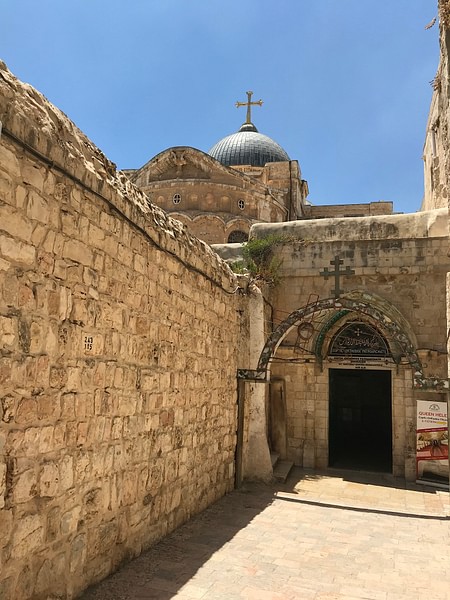
In the Middle Ages, pilgrims began identifying other sites associated with the story. On Good Friday, pilgrims walk this route, known as the Via Dolorosa ("the way of grief") in a reenactment of the suffering of Jesus, known as "the stations of the cross." The procession ends at the Church of the Holy Sepulcher.
The Garden Tomb, a rock-cut tomb with the covering stone still intact, to the north of the Old City on the Damascus Road, is a popular site for the tomb of Jesus for many Protestant denominations. Discovered in 1894, it has since been dated by Israeli archaeologist Gabriel Barkay to the 8th or 7th century BCE. However, the re-use of tombs was common, although this would contradict the gospel claim that Jesus was laid in a "new tomb."
Other sites associated with the gospels are:
- the Church of All Nations on the Mount of Olives at the ruins of the olive press known as Gethsemane
- the Church of the Ascension at the top of the Mount of Olives; the site of Jesus's ascension into heaven
- the Benedictine Dormition Abbey; the site where Catholics claim that Mary, the mother of Jesus, “fell asleep” and was carried to heaven by angels
- the tomb of Mary near the Garden of Gethsemane; a site claimed by Eastern Orthodox Christians
- the Upper Room, which Christians believe was the site of "the Last Supper" of Jesus. (This room is part of a complex that was built during the Crusader period and incorporates the tomb of King David in the lower level).
The Armenian Orthodox Christians claim that they were the first Christians to occupy a section of the city after Hadrian's ban against the Jews. In the Armenian Quarter is the Cathedral of St. James (Jesus's brother), the patron of the Armenians, as well as schools and community centers.
Jerusalem serves as the stepping-off point for Christian pilgrimages associated with other gospel sites such as Bethany and Ein Karem. Bethlehem, the site of Jesus' birth, is approximately 25 miles to the south.
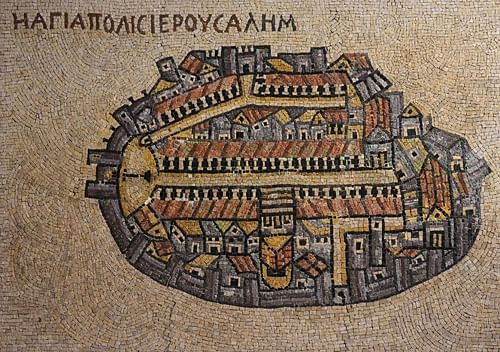
The Byzantine Era (4th century to 1153)
Constantine moved the capital from Rome to Byzantium and renamed it Constantinople in 330 CE. This new center of the Roman Empire survived for another thousand years after the fall of the Western Roman Empire. This era saw the building of many churches in Jerusalem and archaeologists continue to uncover ruins in and around Jerusalem. One of the significant discoveries from this period was the floor of the Byzantine-era church in Madaba, Jordan. Known as the "Madaba Map," it is a 6th-century CE mosaic of a map of sites from Lebanon to Jordan. In the center is a map of Jerusalem, showing the holy sites as known during that time. It remains one of the oldest maps to survive from the ancient world.
Islamic Jerusalem
Jerusalem was captured by Islamic forces in 638 CE. In 691 CE, the Umayyad Caliph Abd al-Malik commissioned the building of the shrine known as the Dome of the Rock on the site of the destroyed Second Temple. The Dome of the Rock is one of the oldest examples of Islamic architecture, and is known as the Haram-esh Sharif, or "the Noble Sanctuary." After Mecca and Medina, this is the third holiest site of Islam. Muslims also claim descent from Abraham, so the traditional site of the Temple Mount as Mt. Moriah is foundational. Inside the shrine is a wooden railing that surrounds the original bedrock. As a shrine, not a mosque, the building is open to all visitors.
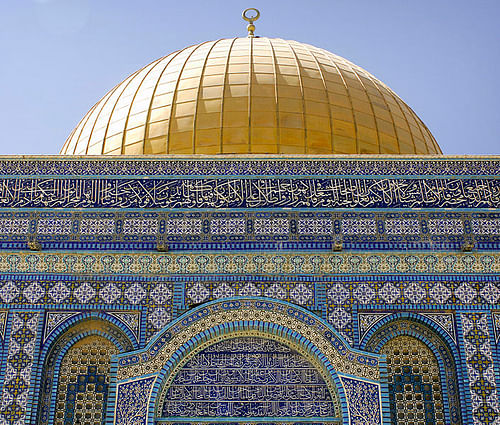
The Prophet Muhammad related an out-of-the-body experience where he traveled to the site in a night journey. The Al-Aqsa mosque, located on the southern side of the complex, is the traditional site of his visit. Initially, Muhammad had believers face this site in Jerusalem during their prayers. After the conquest of Mecca, that city became the locus of prayer.
The Crusader Period
In the First Crusade (1095-1102), Christians were called upon to rescue the Holy Land from Islamic rule. Jerusalem was captured by western allies and became an independent kingdom ruled by Raymond IV and Godfrey of Boullion in 1099. This Kingdom of Jerusalem lasted until 1187 when the city was retaken by Saladin (1137-1193). Many of the churches and monuments were rebuilt during this period and can be seen in various parts of the city.
When one stands atop the walls of Jerusalem, to the east is the Kidron Valley and the Mount of Olives. What appears to be thousands of rocks from a distance are in fact tombstones. Beginning in the Middle Ages (if not earlier), both Jews and Muslims who died abroad had their caskets shipped to Jerusalem for burial here. By tradition, the resurrection of the dead and the final judgment by God will begin at this site.
The Complexity of Jerusalem
Jerusalem remains the historic center of three major religions. This has often fomented tension and sometimes riots. In addition to disagreements over access to sacred space, Jerusalem is also crucial in the historical narratives employed by Jews and Palestinians.
In the continuing debates over sovereignty between the Israelis and the Palestinians, both claim Jerusalem as their capital city. Archaeological excavations in the city are no longer just about the past but contribute to the ongoing issue of which side has the longest historical claim to the city, making all discoveries political.
For decades, the status of Jerusalem has been debated by the UN and other international agencies. In 2016, the population of 850,000 consisted of 60% Jews, 36% Muslims, 1.8% Christians (and 1.2% unclassified). The Statistical Yearbook of Jerusalem (2000) lists 1204 synagogues, 158 churches, and 73 mosques within the city. While most of the tension involves Jews and Muslims, the minority Christian sects often get caught up in the tension as access to their sacred sites can be affected by arguments between the other two.
Unfortunately, it appears that the many claims on Jerusalem will not be resolved in the immediate future. Nevertheless, a visitor can process from one sacred site to another, listening to the sound of the shofar, church bells, and the muezzin. The Old City contains a medieval bazaar, full of the smell of spices and food. It is a wonderful place to reflect on the origins and continuing relevance of the roots of the three western religions of Judaism, Christianity, and Islam.

